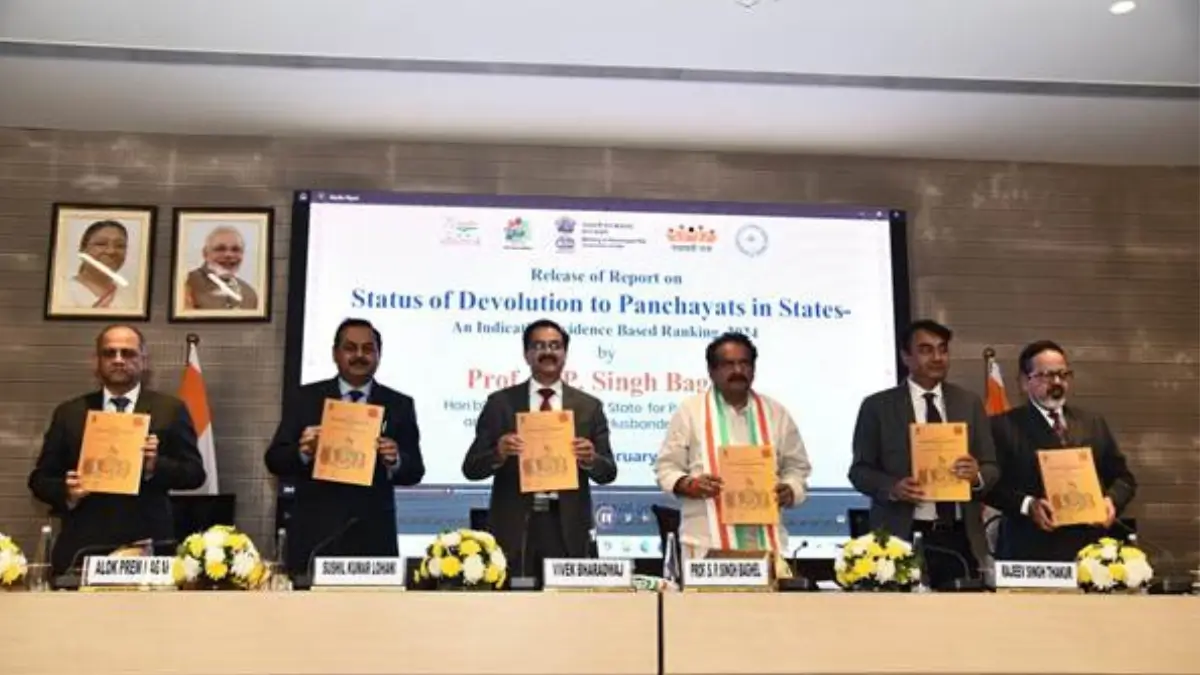- Courses
- GS Full Course 1 Year
- GS Full Course 2 Year
- GS Full Course 3 Year
- GS Full Course Till Selection
- Online Program
- GS Recorded Course
- NCERT (Recorded 500+ Hours)
- Polity Recorded Course
- Geography Recorded Course
- Economy Recorded Course
- AMAC Recorded Course
- Modern India, Post Independence & World History
- Environment Recoded Course
- Governance Recoded Course
- Science & Tech. Recoded Course
- International Relations and Internal Security Recorded Course
- Disaster Management Module Course
- Ethics Recoded Course
- Essay Recoded Course
- Current Affairs Recoded Course
- CSAT
- 5 LAYERED ARJUNA Mentorship
- Public Administration Optional
- ABOUT US
- OUR TOPPERS
- TEST SERIES
- FREE STUDY MATERIAL
- VIDEOS
- CONTACT US
Status of Devolution to Panchayats in States 2024 Report
Status of Devolution to Panchayats in States 2024 Report

- The Panchayati Raj system, institutionalized through the 73rd Constitutional Amendment Act, 1992, stands as the cornerstone of decentralized governance in India.
- To measure the extent of decentralization, the Ministry of Panchayati Raj (MoPR) has introduced the Panchayat Devolution Index (PDI) — a comprehensive tool to assess the actual empowerment of Panchayats across states.
What is the Panchayat Devolution Index (PDI)?
Developed by the Indian Institute of Public Administration (IIPA), the PDI is a quantitative index designed to evaluate how effectively states have devolved the 3Fs — Functions, Finances, and Functionaries to the Panchayati Raj Institutions (PRIs).
Key Dimensions of the Index:
The index scores states on a scale of 0 to 100 based on six dimensions:
|
Dimension/Weights) |
Key Focus |
|
Framework (10) |
Constitutional compliance [elections (Article 243E), reservations (243D)] |
|
Functions (15) |
Actual assignment and execution of functions |
|
Finances (30) |
Fund flow efficiency and autonomy |
|
Functionaries (15) |
Staffing strength and deployment |
|
Capacity Building (15) |
Training and institutional development |
|
Accountability (15) |
Transparency, audits, Gram Sabha functioning |
|
Total-100 |
|
Why is the Devolution Index Needed?
- Strengthening Cooperative Federalism: Encourages states to adopt best practices and secure performance-based grants (as per 15th Finance Commission recommendations).
- Measuring Multidimensional Devolution: Standardizes assessment of political, administrative, and financial devolution across diverse state contexts.
- Assessing Local Government Autonomy: Helps gauge the independence of Panchayats in service delivery and decision-making.
- Fostering Competitive Governance: Ranking and benchmarking stimulate states to improve performance, akin to Ease of Living Index for urban areas.
- Identifying Governance Gaps: Pinpoints disparities and aids in targeted policy interventions (e.g., NITI Aayog’s Aspirational Districts Programme).
Benefits of the Devolution Index
|
Stakeholder |
Benefits |
|
Citizens |
Better transparency and service delivery (e.g., MGNREGA Social Audits) |
|
Elected Representatives |
Data-driven advocacy for stronger decentralization (e.g., Himachal Pradesh’s PESA advocacy) |
|
Government Officials |
Policy roadmap for improving governance (e.g., Chhattisgarh’s Gram Mitra Initiative) |
|
Policymakers |
Evidence-based insights to design effective policies |
PDI 2024: Top three State/UTs
|
Rank |
State |
Score |
|
General category State |
||
|
1 |
Karnataka |
72.23 |
|
2 |
Kerala |
70.59 |
|
3 |
Tamil Nadu |
68.38 |
|
Northeastern/Hilly States |
||
|
1. |
Tripura |
57.58 |
|
2. |
Himachal Pradesh |
53.17 |
|
3. |
Uttarakhand |
49.11 |
|
Union territories |
||
|
1. |
Jammu and Kashmir |
27.85 |
|
2. |
Andaman & Nicobar Islands |
27.15 |
|
3. |
Lakshadweep |
18.32 |
|
National Average Score |
43.89 |
|
Devolution Index Category-Wise Classification
|
Category |
Score Range |
States |
|
Very High |
>60 |
Karnataka, Kerala, Tamil Nadu, Maharashtra, Uttar Pradesh |
|
High |
55–60 |
Gujarat, Rajasthan, Chhattisgarh, Tripura, etc. |
|
Medium |
50–55 |
Andhra Pradesh, Odisha, HP |
|
Low |
44–50 |
Bihar, Assam, Uttarakhand, Sikkim |
|
Very Low (Below national Average) |
<43.89 |
Jharkhand, Puducherry, Haryana, Punjab, etc. |
Key Highlights of PDI Report
- Overall Devolution: Rose from 39.9% (2013-14) to 43.9% (2021-22).
- Functionaries Index: Increased by 28.5%, from 39.6% to 50.9%.
- Capacity Building Index: Improved by 24%, supported by RGSA 2018.
- Financial Devolution: Rose from 32.05 to 37.04 nationally.
- Top Performers: Karnataka, Kerala, Tamil Nadu.
- Notable Reforms:
|
State |
Initiative |
Outcome |
|
Kerala |
People’s Plan Campaign |
Bottom-up project execution |
|
Karnataka |
Decentralized Finances |
Timely fund disbursement |
|
Tamil Nadu |
E-Governance |
Transparency and monitoring |
|
Maharashtra |
GPDP |
Community-based development |
|
Rajasthan |
50% Women Reservation |
Enhanced female participation |
Representation & Inclusiveness in Panchayats (2024)
- Total Panchayats: Increased from 2.48 lakh (2013) to 2.62 lakh (2024)
- Average Population per Panchayat: 3,087 → 4,669 (indicating consolidation)
- Women’s Representation:
- Highest: Odisha (61.5%), HP (57.5%), TN (57.32%)
- Lowest: UP (33.33%)
- States with 50%+ representation: Increased from 11 → 16
- SC/ST/OBC Representation:
|
Group |
Highest Representing State |
National Avg. |
|
SCs |
Punjab (36.34%) |
18.03% |
|
STs |
Chhattisgarh (41.04%) |
16.22% |
|
OBCs |
Bihar (39.02%) |
19.15% |
Challenges in Effective Panchayat Empowerment
- Over-centralization & Fund Delays (e.g., only 60% 15th FC grants utilized in Bihar & Jharkhand)
- Uneven Devolution & Political Interference
- Inadequate Infrastructure & Staffing (e.g., AP: 5% pucca buildings, Odisha: only 13% panchayats with computers)
- Digital Divide: Haryana, Arunachal have <1% internet access in Panchayats
- Gender Gaps & Sarpanch-Pati Syndrome
- Low Capacity & Illiteracy among Functionaries
- Data Inaccuracies (45% Gram Sabhas lack financial recordkeeping)
Milestones in the Evolution of Panchayati Raj in India
|
Year |
Milestone / Event |
|
1687 |
Royal Charter issued for the creation of Madras Municipal Body—considered the first step in formal local governance in India. |
|
1842 |
Act X of 1842 provided the first formal legal measure for municipal bodies in British India. |
|
1857 |
Aftermath of the Revolt of 1857 led to fiscal stress—Fiscal decentralization began to be explored as a solution. |
|
1870 |
Lord Mayo’s Scheme introduced fiscal and administrative devolution; also saw enactment of the Bengal Chowkidari Act. |
|
1882 |
Lord Ripon’s Resolution on Local Self-Government—considered the foundational step for democratic decentralization in India. |
|
1907 |
Royal Commission on Decentralisation was constituted to examine decentralisation in governance. |
|
1948 |
Intense debates between Gandhi and Ambedkar on the idea of Gram Swaraj (village self-rule). |
|
1957 |
Balvantray Mehta Committee recommended:
|
|
1963 |
K. Santhanam Committee recommended
|
|
1978 |
Ashok Mehta Committee suggested:
|
|
1985 |
G.V.K. Rao Committee recommended strengthening of Block Development Offices (BDOs) to plan, implement, and monitor rural development programmes. |
|
1986 |
L.M. Singvi Committee recommended:
|
|
1993 |
73rd Constitutional Amendment Act passed:
|
|
1996 |
|
|
2004 |
Union Ministry of Panchayati Raj was created. |
|
2013 |
Thirteenth Finance Commission recommended a share for Panchayats in the Union divisible pool. |
|
2020 |
Prime Minister Narendra Modi launched the 'Vocal for Local' initiative, further encouraging rural economic empowerment through local governance. |
Mandatory Framework of Panchayats
Legal & Constitutional Framework of Panchayats
Key Articles of the Constitution under Part IX:
- 243B: Three-tier Panchayats (village, intermediate, district)
- 243D: Mandates reservation of seats for SCs, STs, and women (including SC/ST women)
- 243E: Regular elections every 5 years
- 243F: Disqualifications
- 243I: Mandates the constitution of State Finance Commission
- 243K: Provides for the constitution of State Election Commission (SEC) to oversee Panchayat elections
- 243ZD: Mandates the establishment of District Planning Committees
|
Also Read |
|
| FREE NIOS Books | |




